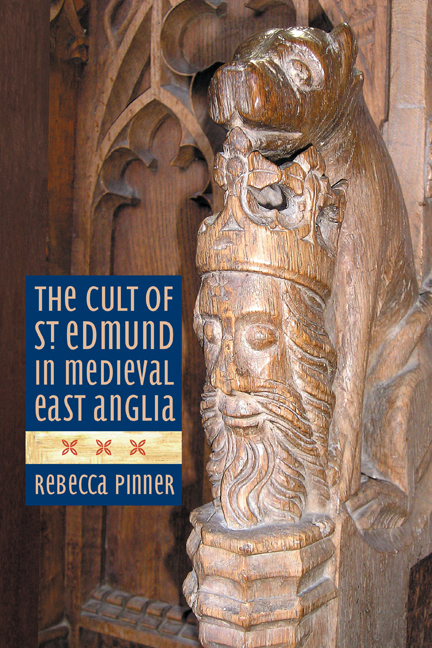Book contents
- Frontmatter
- Contents
- List of Illustrations
- Acknowledgements
- Abbreviations
- Introduction
- Part I Texts and Contexts: the Legend of St Edmund
- Part II Relics, Shrines and Pilgrimage: Encountering St Edmund at Bury
- Part III Beyond Bury: Dissemination and Appropriation
- Conclusion: ‘Martir, Mayde and Kynge’, and More
- Appendix 1 Synoptic Account of the Legend of St Edmund
- Appendix 2 Chronology of Significant Events and Texts Associated with the Cult of St Edmund
- Bibliography
- Index
Chapter 6 - Sacred Immanence, the Incorrupted Body and the Shrine of St Edmund
Published online by Cambridge University Press: 21 May 2021
- Frontmatter
- Contents
- List of Illustrations
- Acknowledgements
- Abbreviations
- Introduction
- Part I Texts and Contexts: the Legend of St Edmund
- Part II Relics, Shrines and Pilgrimage: Encountering St Edmund at Bury
- Part III Beyond Bury: Dissemination and Appropriation
- Conclusion: ‘Martir, Mayde and Kynge’, and More
- Appendix 1 Synoptic Account of the Legend of St Edmund
- Appendix 2 Chronology of Significant Events and Texts Associated with the Cult of St Edmund
- Bibliography
- Index
Summary
‘It is fully proved in his case … that though his spirit be in the enjoyment of heavenly glory, yet it has the power to revisit the body and is not by day or night far separated from the place where the body lies.’
Sacred immanence
IN 1043 King Edward the Confessor visited the abbey of Bury St Edmunds. As the towers of the church became visible in the distance the king dismounted from his horse and walked the last mile on foot, acknowledging that he was crossing the boundary into the spiritual estate under the jurisdiction of St Edmund. In another account recorded by Herman, an old blind man from Northumberland, travelling to Bury with a group of fellow pilgrims, was miraculously restored to sight after kneeling and praying to St Edmund when the bell tower of the abbey church came into sight across the Suffolk fields.
The perceived power of relics as sites of particular miraculous potency was a persistent and influential trope in the medieval cult of saints. The concept of ‘holy radiation’, whereby the saint's power was most potent in close proximity to his/ her relics, provided the ultimate rationale for medieval pilgrimage, along with the understanding that visiting the saint in person evinced a suitable commitment to, and faith in, the saint's powers. The so-called ‘holy hole’ at Winchester under the feretory platform, which Crook suggests allowed pilgrims to crawl beneath the shrine, ‘presumably in order to absorb the holy radiance emanating from Swithun's remains’, is a particularly striking example of the belief that proximity to relics was of the highest importance.
The monks of Bury, in common with the keepers of many shrines, were keen to remind the faithful of the benefits of visiting the saint in person, undoubtedly mindful of the financial rewards this brought to their communities in the form of donations and offerings, and the collections of Edmund's miracles include a number of individuals who appeal for help from afar but are fully healed only when they make the journey to Bury. In this pragmatic context, the trope of visibility in the narrative of the aged Northumbrian is symbolically redolent: ‘see’ St Edmund and you will see again.
- Type
- Chapter
- Information
- The Cult of St Edmund in Medieval East Anglia , pp. 115 - 137Publisher: Boydell & BrewerPrint publication year: 2015

